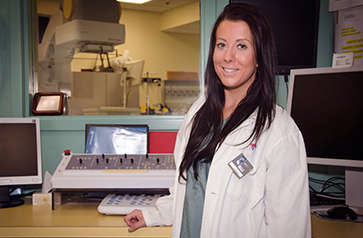Medical Radiation Technologists—where technology meets compassionate care
As an integral part of the healthcare team, medical radiologists perform diagnostic imaging examinations and administer radiation therapy treatments that are focused on destroying tumours of cancer patients. According to the Canadian Association of Medical Radiation Technologists, medical radiation has touched the lives of over 30 per cent of Canadians in the last six months.
Here at the McGill University Health Centre (MUHC), we have a Radiation Oncology Clinic that treats over 2,500 patients per year and uses cutting-edge technology that enables radiation technologists to provide specialized patient-care.
 Lisa Goldenberg, a radiotherapy technologist from the Division of Radiation Oncology at the MUHC’s Montreal General Hospital, shares her experience as a radiation therapist:
Lisa Goldenberg, a radiotherapy technologist from the Division of Radiation Oncology at the MUHC’s Montreal General Hospital, shares her experience as a radiation therapist:
What are the things that you do in order to make a cancer patient feel comfortable with the treatment they’re receiving here at the MUHC?
LG: Our mission is to make every patient feel comfortable and safe. To build trust between staff and patient it can be something as simple as a smile. Frequently we have patients in the waiting room that are nervous; their hands are shaky and they speak nervously. A simple smile, a “Hello, how are you?” and an introduction makes all the difference. The key aspect is to be as empathetic and as friendly as possible. It makes all the difference!
Was there a specific reason why you decided to become a radiation therapist?
LG: It was mostly due to having family members who have had cancer. I know what is like to be in that position, so I feel that I can relate to patients more. I was also very interested by the science of genes and how mutations occur, so this was a perfect opportunity to do something that I like while giving back to others.
Is there a risk of error for this type of treatment?
LG: There are obviously different degrees of error within a department, some more severe and others less. To minimize the risk for errors there are many quality assurance checks, ranging from machine calibration to treatment plan creation. To ensure proper treatment delivery both physicists, engineers, doctors and radiation therapists work closely together to ensure proper function.
What would you say is the most satisfying aspect of your job?
LG: Helping people! Yes, our goal is to give patients treatment that will potentially help kill their cancer cells, but I would say that my job is so much more. My job is not only to cure, but also to help patients cope emotionally. Many of our patients who come into our department have little support or family. Enabling them to talk about themselves and how they feel, is sometimes half the battle. A patient who thinks positively, in my opinion will do better overall, both emotionally and physically.
Is there anything you’d like people to know about your job as a medical radiation technologist?
LG: I find that very few people know about radiation oncology. Habitually people think that I am a nurse or work in medical oncology (chemotherapy). When I tell them I work as a radiation oncology therapist, I get blank stares or puzzled looks. Radiation therapists use advanced computer systems to operate sophisticated radiation therapy equipment. They effectively design and treat the course of radiation treatment, in addition to managing the patient's well-being. It is a field that is mentally challenging, stimulating and very hands on.
